|
HISTORY of DIAGONAL, RINGGOLD COUNTY, IOWA
K&W Depot, Diagonal, Iowa
Courtesy of digital.lib.uiowa.edu/railraodinan
In 1880, the Chicago, Burlington & Quincy (CB&Q) Railroad passed through the town of Goshen. In 1885 the Chicago Great Western
Railroad (CGW) came through Knowlton. At a point approximately two miles from Goshen and Knowlton the tracks crossed diagonally with
the CB&Q passing on a creaky bridge with the CGW on firm ground. This crossing became a hub of actitivy with passengers
changing trains as needed. Ultimately, the people felt that there was a need to provide lodging and meals for the passengers
at this cross. Thus, the town of Diagonal was officially incorporated in 1888 at this crossing. Originally the newly founded
town was called "Hak-a-dady." In February the name of Morton was adopted in honor of Governor O. P. MORTON of Indiana. In March
of 1889, the town was re-named Diagonal.
The first building was moved from Goshen to Diagonal on April 1, 1889. Soon the townspeople and businesses of Goshen
followed, relocating at Diagonal. By 1896, the
townspeople of Knowlton began to migrate to Diagonal.
With eight passenger trains a day stopping at Diagonal, the town flourished. As many as 150 people used the facilities in
one day. This, of course, brought business into the town as people sought meals, lodging, and livery services.
The town of Diagonal fell to her knees when a fire swept through the business
district in February of 1899. However, the townspeople rebuilt their businesses. A second fire occurred on May 17, 1906, claiming
the Blue Front Livery, James BELL's home, and the Diagonal Hotel.
Diagonal before 1909
Diagonal Post Office
With the Burlington Railroad running east and west, the Chicago Great Western running north and south through
Diagonal, the town had top mail service since its beginning. The railroads played an important part in the arrival and
dispatch of mail and they were fortunate to have had good Star Route carrier service and dedicated personnel.
In July 1889, Diagonal petitioned for and was granted a post office to be called Diagonal, with townsman,
W. A. HARVEY as postmaster. It is believed the first post office was located near the Burlington Depot on the north side
of the PORTER Hotel. In 1901, two rural free mail routes were established at 24 miles long compared to routes
of over 100 miles today. The post office was moved in 1903 to the new brick building built by OSTRANDER and FOGLE,
on the site where the Diagonal café was located in 1988. In 1919, the post office was moved across the street beside
the White Way Bakery, which was later Pearl KOKESCH’s middle building. In 1925, D. V. FERRIS built a building on the
south side of the present bank building, and the post office moved up the street to that location and remains there
today. With the closing of the Knowlton post office in 1921, there were five routes, but they have been combined
into two, with one of the routes serving Clearfield patrons. Dick YASHACK, with over 27 years as postmaster, and
Carrol MATTHEWS, with over 22 years as clerk, were the
longest postmaster and clerk combination in the Diagonal Post Office history. YASHACK was also the first postmaster to
retire from this office, with MATTHEWS and HANSHAW following. Postmasters were replaced with each change of political
administration until the Dwight D. EISENHOWER administration. A bill was passed to do away with this policy to protect
all government workers. POSTMASTERS OF DIAGONAL
William A. HARVEY, June 15, 1889
Robert HANNELY, July 26, 1893
Henry TODD, September 16, 1897
Robert BAILEY, October 24, 1910
Edna F. BROWN, February 1, 1915
Burdette HERSOM, February 24, 1917
Joseph H. DICKENS, March 22, 1922
Bernard DOLECHECK, June 18, 1934
Ellis WILEY, May 9, 1941
Kenneth MORROW, July 28, 1947
Allen R. YASHACK, April 15, 1953
Carroll MATTHEWS, February 21, 1981
Paul F. HANSHAW, January 23, 1982
Gail HOOD, November 26, 1983
Bert LOCKARD, 1988
Mount Ayr Record-News
Mount Ayr, Ringgold County, Iowa
July 05, 1916
DIAGONAL - Work has begun Tuesday on the new bandstand at the corner of Third and Main Streets. The stand will be 14 feet square, eight feet to the floor and have a large arch at each end of the four sides to allow access to the cistern over which it stands. Arrangements have been made with the Williams Garage to light the stand with electricity. Transcription by Sharon R. Becker, October of 2016
DIAGONAL PRINTING MUSEUM
The local newspaper was The Diagonal Progress. It was published weekly, coming out on Thursdays. C. F. QUINN was the
publisher and editor, and Tom WAFFLE assumed duties as the editor later on. The Diagonal Progress was in
publication until 1918 when it was renewed as the Diagonal Reporter. The Diagonal Reporter was published
from 1918 until 1972, with Harold and Mildred TURNBULL as editor and publisher in the 1950's.
Just at the time of the TURNBULL's retirement, offset printing was coming into use. No more did the page forms, heavy
with lead, require two persons to carry them to the press. But those of the old school held the "paper, paste,
scissors" method in a mild sort of contempt finding it not so clear, not so sharp as the hot type method, doubting
it would reach the standard it has today.
The Reporter machinery is the property of the Diagonal Printing Museum, as is the building.
The Mergenthaler linotype, bought rebuilt about 1925, is still operating. The huge and noisy Babcock news press is
there, too, giving truth to what an itinerant "tramp" printer said years ago:
"That press will be running long after you and I are gone."
There are cases of hand type, and the Chandler-Price hand-fed job press.
The marble-topped "stones" used as work tables are there too, the inches thick marble grayed by years of printer's
ink. In the early days when an editor or printer died, that marble was often used as his tombstone.
Harold TURNBULL; Reporter office - Ann LINKEY, Harold & Mildred;
Mildred WILEY TURNBULL
A committee of Diagonal area residents and former residents contributed to the purchase of the Diagonal Reporter
Office from Harold and Mildred TURNBULL in 1983. It has since been painted by the Lions Club and a cement step and ramp has been added at the front entrance. This is
the only printing museum in Iowa with the linotype set-up and printer all set in place. There is also a room in the
museum containing a record of family genealogy that now has hundreds of family histories.
Diagonal Printing Museum is open each weekend, on Saturday and Sunday afternoons 2:00-4:00 from Memorial Day through
Labor Day.
The Diagonal Progress is the town's present-day newspaper.
DIAGONAL'S BANKS
Diagonal’s first bank was located in one of the many little wooden buildings along Main Street. After the bank was robbed
they installed a new safe with a crank double time lock. Mr.
SCHEE was in charge of the bank at this time. In the year 1896, the bank, called Bank of Diagonal, was moved into the
new room in the Opera House.
Mr. E. DUFUR of Lorimor bought the bank in 1908 and reorganized it as National Bank. Mr. D. V. FERRIS of Lamoni
was the new cashier.
When the Opera House was destroyed by fire in December 1917, the bank moved temporarily across the street to the old REED
building. A new bank was started in April 1918 and completed in August which still stands today.
In September 1935, M. I. ROBERTS became president of the First National Bank. The bank was changed from First National
Bank to First State Bank in November 1937. Mr. ROBERTS made other improvements in the bank with the installation of
theft-proof safe deposit boxes in 1948. The bank was redecorated for an open house that was held in honor of Mr.
ROBERTS’ 50th year in banking, having started in Knowlton. Up until this time about all the owners or cashiers of
the bank have been related in some way.
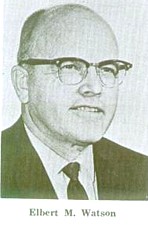 In the early 1960s, Elbert "Doc" WATSON, took over the ownership of the bank and continued until 1968 when Al WISSINK
bought the bank from the WATSON estate. The main office is located in Mount Ayr now with offices in Shannon City and
Diagonal.
In the early 1960s, Elbert "Doc" WATSON, took over the ownership of the bank and continued until 1968 when Al WISSINK
bought the bank from the WATSON estate. The main office is located in Mount Ayr now with offices in Shannon City and
Diagonal.
* * * *
Twice-A-Week News
Mount Ayr, Ringgold County, Iowa
Thursday, November 16 & 19, 1916
Diagonal is to have a new bank, which will be known as the Diagonal State Bank, and which will be opened about January 1, with a capital of $30,000. They will probably erect a new bank building in the near future, but for the present they will occupy the office of Asa BAILEY.
Transcription by Sharon R. Becker, November 21, 2015
* * * *
A new bank was planned in 1915, to be called the Diagonal State Bank. The officers were: M. Z. BAILEY, president; Asa
BAILEY, vice president; Rolla BAILEY, cashier. A new building had already been started by Asa and Robert BAILEY just
south of the large hardware on the corner. The building had the lettering "Diagonal State Bank, 1916" on the front.
In February 1916, they had their grand opening and the ladies attending
received a carnation.
In 1934, the Diagonal State Bank merged with the Mount Ayr State Bank. Carson WILLIAMS, who was at the bank at that
time, also moved to Mount Ayr as executive vice president.
FIRST STATE BANK, 1968
Left to Right: Dixie (WATSON) TAYLOR, Alberta (MILLER) WATSON,
Ethelyn HERRINGTON, Darlene (BENSON) LININGER, M. I. ROBERTS
The Diagonal State Bank building was demolished in 1996.
Pete OSMAN, "The Hardware and Implement Man"
Peter OSMAN (1874-1948) was a native of Bohemia. Pete was a cobbler and operated a shoe repair shop. He was married
to Antonie OSMAN (1871-1933). They were interred at
Bohemian Cemetery. Click
here to see enlarged view of ad. Click back button to return to this page.
1938 Boys' State Basketball Championship Parade
in front of Diagonal Bowling Alley
DIAGONAL BUILDING SUPPLY
When DALBEY Lumber decided to leave Diagonal, they helped Ken MORROW get a lumber business started.
Ken purchased the lower buildings from DALBEY's, but was set up in the big building while he remodeled them.
Since Ken was a rural mail carrier, the business was open in the afternoons only. In 1980, after retiring from the rural
route, Ken sold the lumber business to Frank GUNSOLLEY.
DIAGONAL BUILDING PRODUCTS
Diagonal Building Products started business in May 1980. Frank and Joan GUNSOLLEY purchased the land and
buildings from Kenny and Beva MORROW. Shortly after opening the new business, Frank and Joan bought the major part of
the inventory of KOKESH Farm Supply. KOKESH Farm Supply was operated at that time by Pearl KOKESH. The inventory and
several display cases were moved from "Auntie Pearl's" building up to the Diagonal Building Products building.
Diagonal Building Products is a retail lumber and hardware business but carries many farm-related hardware
items, which KOKESH Farm Supply had made available to area farmers for many years.
Frank, who has a degree in Architecture from Iowa State University, provides area residents the benefit of
a professional approach to their new construction or remodeling plans. This is a service few lumberyards anywhere are
capable of providing to their customers.
SCHLAPIA, INC.
In May 1956 the building now occupied by SCHLAPIA, Inc., was purchased from Dalbey Lumber Co. by
Hugh SCHLAPIA. The feed, seed, and fuel business established was called Hugh SCHLAPIA and Sons. The firm incorporated
in 1965 and then became known as SCHLAPIA, Inc.
Hugh and his oldest son, Jerry, were the main organizers and principles. The second oldest son, Alvin, after completing
college and spending ten years in Omaha, Nebraska, returned to work with them in 1970. The third son, Ron, joined the
business in 1972, after three years of college and three years of military service. Robert, the youngest of the four,
started to work full-time after graduating from high school in 1972. Mark, Jerry’s son, joined the firm in 1978, after
completing two years of college. Alvin, Ron, Robert, and Mark all had worked part-time during their school years.
Wives were, and are an important part of the business. Vivian (Hugh), Vonnie and Rosemary (Jerry), Mary Ann (Alvin),
Toni, (Ron), Cindy (Robert), and Ruthie (Mark) have all "pitched in" when needed. Hugh was a victim of a massive
coronary in 1976, and Jerry succumbed to complications of lifetime diabetes in 1978. The firm practices the standards
and remembers proudly the achievements of Hugh and Jerry.
Much of the first year was spent revising the purchased building to accommodate various services and
inventory. Included were a feed warehouse, stationary hammer mill and mixer, and some grain storage. The first
brand line of feed sold was Rath Feed. The firm also began to sell Sargents, which was later purchased by Supersweet.
Supersweet became the mainstay and was sold for approximately 20 years. In 1972, Tru Pro, a private line, was
manufactured for resale. The firm changed to Wayne Feed in 1981. Supersweet again became the main line in 1986.
Many people hauled grain to town, put it through the hammer mill and mixer, and hauled it back home just so they
could scoop it off into a feeder. As livestock feeding increased in the area, it was simplified by the purchase of a
used mobile mill in 1962. A new replacement mill was purchased in 1965. Many people can remember the long hours, mud,
and other experiences with the mills. In 1972, a permanent feed mill was erected at the store. To increase grain
storage at the mill, a 15,000-bushel steel bin was built the same year.
The firm’s first addition to its grain facilities were three 6,000-bushel bins just to the north of the
store in 1959. Seeing a need for more storage and a corn-drying system, the firm purchased the two flat buildings and
scales by the railroad from Howard and Eugene PINE in 1967. A Chicago Eastern dryer and its support system were
installed on this site. As farm technology increased, and the need arose, more storage was built. In 1982,
grain-cleaning equipment was installed and extensive work was done to the dryer. In 1983, the firm purchased its
first pneumatic grain conveyor and has since added two power takeoff conveyors to its line of grain handling equipment.
Another division of the firm is its petroleum business, both retail and wholesale. Hugh had experience in
the petroleum business by operating the Phillips 66 station in the late 1940s. He purchased his first tank wagon in
1950 when he became a Skelly agent, hauling product from the Skelly bulk plant in Mount Ayr. The tank wagon service
was incorporated into the business at the beginning. As business increased, a bulk plant was shipped by rail from
Webster City, Iowa and set up on the west edge of Diagonal in the winter of 1957. SCHLAPIA, Inc. became a Skelly
jobber and supplied wholesale product to gas stations in neighboring communities. The firm’s brand affiliation
changed to Texaco acquired by the Skelly/Getty Refining Company in 1985.
Many things have changed since the days of being open on Wednesday and Saturday nights, the ice cream
socials in "Hop" SNODGRASS' building and the Saturday night shows. SCHLAPIA, Inc. is proud to have been a part of
Diagonal's history and plans to continue meeting the need for services in the Diagonal community.
Diagonal Depot
Flood, June 7, 1909
Mount Ayr Record-News
Mount Ayr, Ringgold County, Iowa
1980
Growth in Diagonal
Diagonal was one of the few towns under 500 in this part of Iowa to grow in population from 1970 to 1980. Diagonal had a growth
rate of a little over 10% in the past ten years. However, the rural areas around Diagonal lost ground in the past ten years.
Diagonal reached its peak population in 1940, which is also unlike most smaller towns in this area of Iowa. The 1940
census shown Diagonal was over 600 persons. Below is a list of the census counts for Diagonal since 1900:
1980 - - 362
1970 -- 327
1960 -- 437
1950 -- 472
1940 -- 603
1930 -- 577
1920 -- 569
1910 -- 515
1905 -- 469
1900 -- 383
Diagonal's population was 312 people in the 2000 Census.

Chicago NorthWestern Railroad, Diagonal, Iowa
Courtesy of digital.lib.uiowa.edu/railraodinan
Mount Ayr Record-News
Mount Ayr, Ringgold County, Iowa
Thursday, October 22, 2015, Page 8

By Mike Avitt
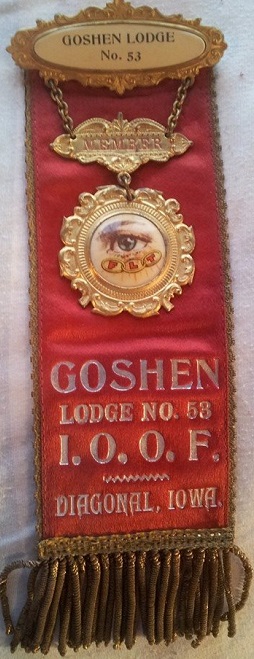 Some of the buildings in this postcard picture may have been moved to Diagonal from Goshen. I don't have any Goshen photos so I ran
this one. Goshen, as you know, was located one and one-quarter mile west of present-day Diagonal. When the Chicago, St. Paul, and Kansas City Railroad (later
called the Chicago Great Western) built a mainline track east of Goshen, and under the Humeston & Shenandoah, the town moved its buildings to the crossing
in 1889.
Some of the buildings in this postcard picture may have been moved to Diagonal from Goshen. I don't have any Goshen photos so I ran
this one. Goshen, as you know, was located one and one-quarter mile west of present-day Diagonal. When the Chicago, St. Paul, and Kansas City Railroad (later
called the Chicago Great Western) built a mainline track east of Goshen, and under the Humeston & Shenandoah, the town moved its buildings to the crossing
in 1889. By 1896, Diagonal had over 300 residents. And I see many more Bohemian names connected with Diagonal than I did with Goshen. The heart of the Bohemian
community was a few miles south of Diagonal. The Keokuk & Western put in side tracks at Diagonal and by July 11, 1889, all railroad business that had been
done at Goshen was now being done at Diagonal. The town of Goshen lasted from 1882 to 1890 and this was before photographs became common in Ringgold County.
Also, Goshen disappeared quickly, unlike Caledonia or Knowlton which lingered for decades. This makes research more difficult. I have some good news,
though. Liz Wiley has written a new Diagonal history book and I have already ordered mine. It should be out soon.
Photograph courtesy of Mount Ayr Record-News
Transcription by Sharon R. Becker, October of 2015
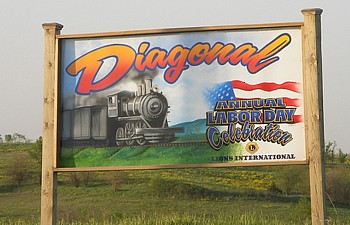
Mount Ayr Record-News
Mount Ayr, Ringgold County, Iowa
Thursday, February 04, 2016, Page 9
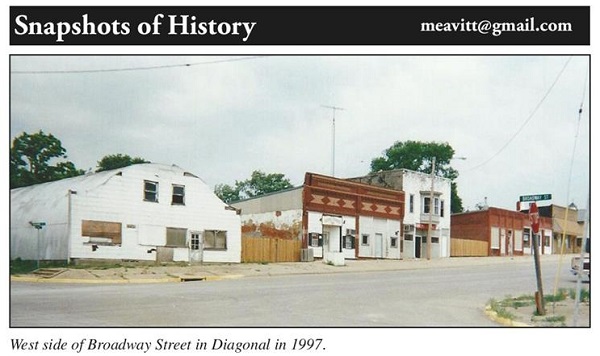
By Mike Avitt
I took this photo without really planning to do so. I pulled up to the stop sign, saw the sun was just right, and stepped out with my camera. I didn't have plans for the picture at the time
but, almost twenty years later, it fits this week's topic. Barb Stephens called to tell me my copy of Diagonal, Iowa - Volume II History was ready for me to pick up. This history book
takes up where the Diagonal Cetennial book leaves off. The book committee consisted of Barb Stephens, Shawna Fletcher, Rhonda Lohmann, Nora Andrews, Jan Johnston, Cheryl
Whittington, Danielle Newton Grace, Judy Newton, and Liz Wiley. Proceeds from the book go to the United Church of Diagonal building fund. A lot has happened in Diagonal since
1988 and much of it is captured in this book. Church, school, business, and organization histories are updated in this hard-bound volume, as well as family histories. Judy Newton
and Liz Wiley wrote the Diagonal Iowa Centennial History in 1988. I consider this book and Maloy's centennial book to be the best of Ringgold County's ten centennial books. Liz has
an incredible photo collection and many of her photos can be found in the Diagonal centennial book. Ringgold County has done a good job of recording its history. Remember the
column, "History Highlights," in the Mount Ayr Record-News? These articles were furnished by the Ringgold County Historical Society and ran for decades. And there are four
museums in Ringgold County; one each in Diagonal, Mount Ayr, Ellston, and Kellerton. Thanks to everyone who keep Ringgold County history alive and thanks to those who
support the efforts of authors, historical societies, and museums in and out of Ringgold County. Transcription by Sharon R. Becker, October of 2016
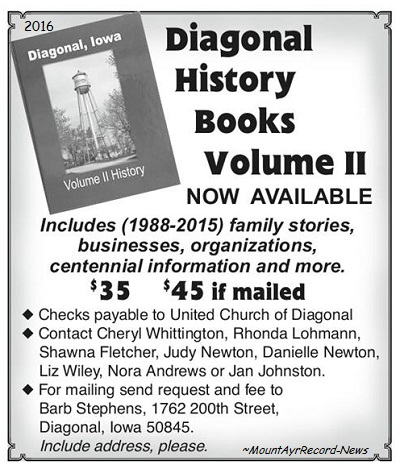
Mount Ayr Record-News
Mount Ayr, Ringgold County, Iowa
Thursday, October 06, 2016, Page 9
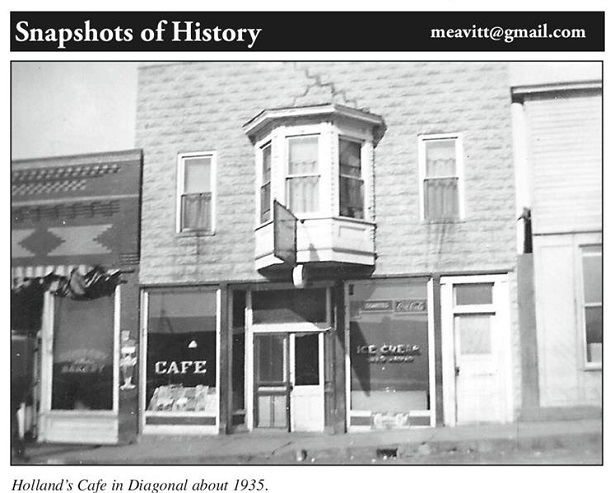
By Mike Avitt I recognized this building the moment I saw the picture - Velda's! This was Diagonal Snooker in my youth and was owned by Velda Smith. I seem to remember coming here on at least one occasion when my good-time buddy and I skipped school and didn't want to get caught in Mount Ayr. Thanks to Susie Rush for this week's photo. Susie donated a large collection of photos, newspapers and genealogy to the Mount Ayr Depot Museum from the estate of the late Paul Holland. Most of the collection was related to Paul's mother's side of the family. She was the former Patricia Simpson from Bedford. Paul's father was Richard Edward Holand who graduated from Diagonal High School in 1938. Richard, unfortunately, was not on the basketball team that won the state championship that year.
Richard's parents were Robert L. and Leah Holland and it's their restaurant we are looking at this week. An advertisement in the November 22, 1928 Diagonal Reporter tells us Mr. and Mrs. Robert Holland bought Jim's Cafe from Mr. and Mrs. Bryan Lee. The new name was Bob's Cafe. It would later be called Holland's Cafe. When I enlarge the photo on my computer, I can see a "Country Club Beer" sign at the base
of the right window so this was also a tavern. The Hollands had the business for fifteen years. In May of 1943, Mr. and Mrs. Holland traded their business to Mr. and Mrs. Frank Tepley for a farm. The Diagonal Reporter for July 1, 1943, carries an advertisement saying the Tepley Cafe is now open seven days a week. I received a "Tepley's Tavern" matchbook from Rex Ruckman recently The matchbook lists Frank Tepley as the proprietor and
gives the phone number as 88. Velda Duke Smith eventually bought the tavern from the Tepleys. Robert and Leah Holland returned to farming, which is what they had done before being in the restaurant business Their farm was in the Beaconsfield area, near where Robert was born. Robert L. Holland was one of twelve children born to Richard A. and Fannie A. Holland of Beaconsfield. Robert's brother Sam owned Mutt's Cafe and Mount Ayr Billiard Parlor in Mount Ayr. Another brother, Arthur, owned the Mount Ayr Hotel and the Continentel Hotel in Centerville. Researching the Holland family hasn't been easy. At Robet L. Holland's funeral, two of his pall bearers were named Robert Holland and two others were named Richard Holland. I haven't found all the obituaries yet, but, when I do, I'll bring you more on the Holland family.
Transcription by Sharon R. Becker, May of 2017

SOURCES:
Ringgold County History, Compiled and written by the Iowa Writers' Program of the Work Projects Administration in the State of Iowa, Sponsored
by Ringgold County Superintendent of Schools, Mount Ayr, Iowa. 1942.
Diagonal Centennial History: 1888 - 1988
Compiled & Submitted by Sharon R. Becker, 2009; updated April of 2010; October & November of 2015; updated May of 2016; updated October of 2016; updated May of 2017


|